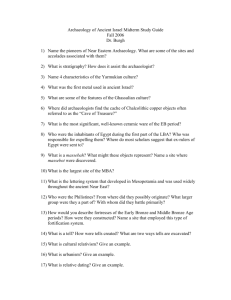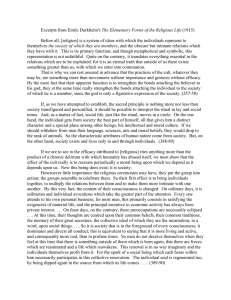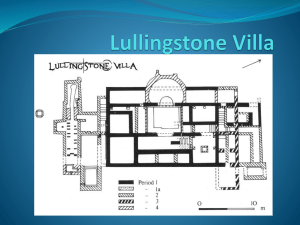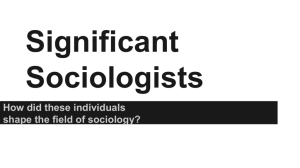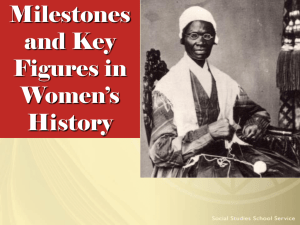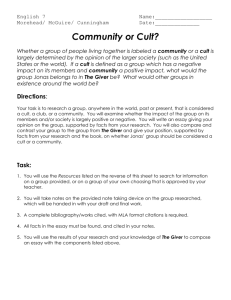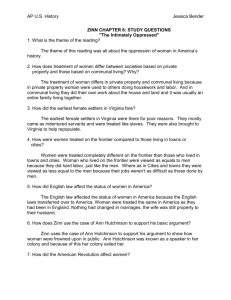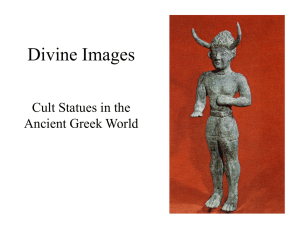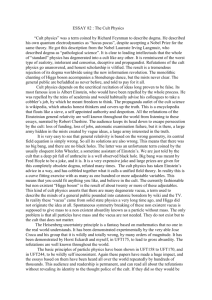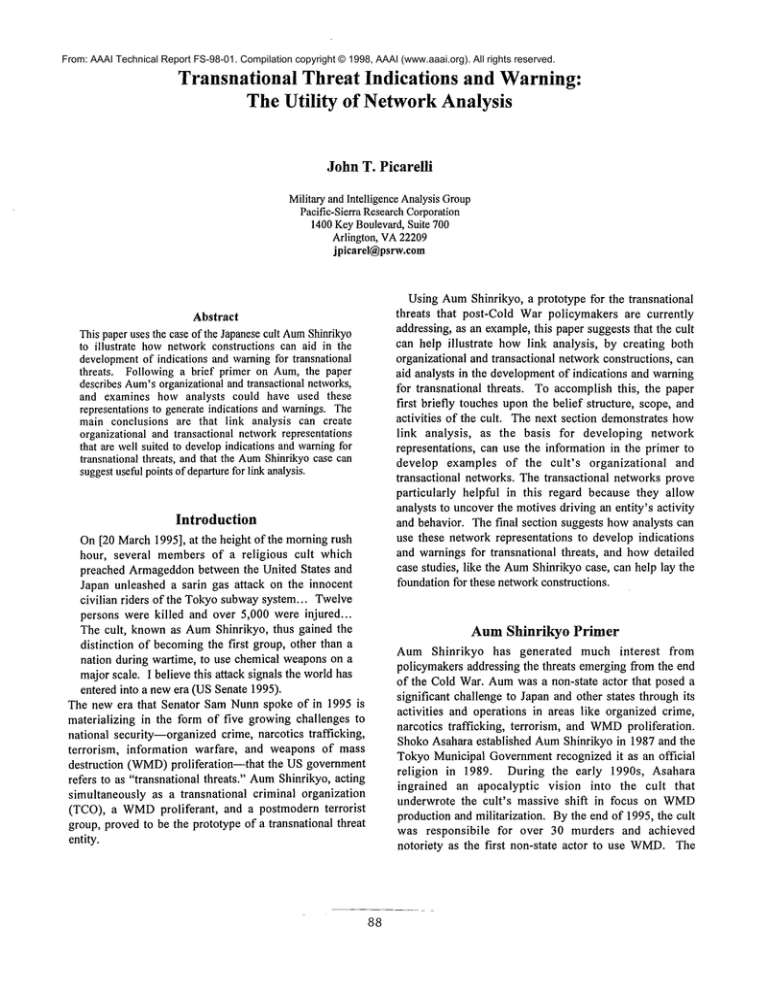
From: AAAI Technical Report FS-98-01. Compilation copyright © 1998, AAAI (www.aaai.org). All rights reserved.
Transnational Threat Indications and Warning:
The Utility of NetworkAnalysis
JohnT. Picarelli
Militaryand IntelligenceAnalysisGroup
Pacific-SierraResearchCorporation
1400KeyBoulevard,Suite 700
Arlington, VA22209
jpiearel@psrw.eom
Abstract
Thispaperuses the case of the Japanesecult AuraShinrikyo
to illustrate hownetworkconstructions can aid in the
developmentof indications and warningfor transnational
threats. Following a brief primer on Aum,the paper
describes Aum’s
organizationaland transactional networks,
and examines how analysts could have used these
representations to generate indications and warnings.The
main conclusions are that link analysis can create
organizational and transactional networkrepresentations
that are well suited to developindications and warningfor
transnational threats, and that the AumShinrikyocase can
suggestusefulpointsof departurefor link analysis.
Introduction
On[20 March1995], at the height of the morningrush
hour, several members of a religious cult which
preached Armageddonbetween the United States and
Japan unleashed a sarin gas attack on the innocent
civilian riders of the Tokyosubwaysystem... Twelve
persons were killed and over 5,000 were injured...
The cult, knownas Aura Shinrikyo, thus gained the
distinction of becomingthe first group, other than a
nation during wartime, to use chemical weaponson a
majorscale. I believe this attack signals the world has
entered into a new era (USSenate 1995).
The new era that Senator SamNunn spoke of in 1995 is
materializing in the form of five growing challenges to
national security--organized crime, narcotics trafficking,
terrorism, information warfare, and weapons of mass
destruction (WMD)
proliferation--that
the USgovernment
refers to as "transnational threats." AumShinrikyo, acting
simultaneously as a transnational criminal organization
(TCO), a WMD
proliferant,
and a postmodern terrorist
group, proved to be the prototype of a transnational threat
entity.
88
Using AumShinrikyo, a prototype for the transnational
threats that post-Cold War policymakers are currently
addressing, as an example,this paper suggests that the cult
can help illustrate howlink analysis, by creating both
organizational and transactional networkconstructions, can
aid analysts in the developmentof indications and warning
for transnational threats. To accomplish this, the paper
first briefly touches upon the belief structure, scope, and
activities of the cult. The next section demonstrates how
link analysis, as the basis for developing network
representations, can use the information in the primer to
develop examples of the cult’s organizational
and
transactional networks. The transactional networks prove
particularly helpful in this regard because they allow
analysts to uncoverthe motives driving an entity’s activity
and behavior. The f’mal section suggests howanalysts can
use these network representations to develop indications
and warnings for transnational threats, and how detailed
case studies, like the AuraShinrikyo case, can help lay the
foundation for these networkconstructions.
AumShinrikyo
Primer
Aum Shinrikyo has generated much interest
from
policymakers addressing the threats emergingfrom the end
of the Cold War. Aura was a non-state actor that posed a
significant challenge to Japan and other states through its
activities and operations in areas like organized crime,
narcotics trafficking, terrorism, and WMD
proliferation.
ShokoAsahara established Aura Shinrikyo in 1987 and the
TokyoMunicipal Governmentrecognized it as an official
religion in 1989. During the early 1990s, Asahara
ingrained an apocalyptic vision into the cult that
underwrote the cult’s massive shift in focus on WMD
production and militarization. By the end of 1995, the cult
was responsibile
for over 30 murders and achieved
notoriety as the first non-state actor to use WMD.
The
underlyingfactors that fueled these activities are the cult’s
belief structure and Aum’swealth of resources.
Shoko Asahara, Aum’s supreme leader, guided the
formation of the belief structure through a series of
writings and teachings that he disseminated to a worldwide
audience using modemcommunications technologies like
the Internet. Aum’s belief structure rested upon two
pillars, the first of which borrowedselected tenets from
some of the world’s major religions. Asahara broadly
based the religious pillar of Aumon prayers to Shiva, the
Hindugod of destruction, along with more specific ideas
from other major religions of the world, such as
Armageddon(US Senate 1995). Consequently, the cult’s
beliefs rested more on the commonidea of the end of the
world by divine intervention than on any particular
religious teaching. Asahara derived the other pillar of
belief from science fiction. Drawingan analogy between
his growingcult and the secret society of elite humansin
the Foundation trilogy of Isaac Asimov, Asahara stated
that Aumwould found a new and more enlightened society
following a cataclysmic war between the USand Japan.
Asahara preached that Aummust prepare itself to survive
this Armageddon
and found the new society afterwards. He
asserted that only he had the powerto predict the date of
the comingapocalypse, although he frequently changed it
as he descended into an increasingly paranoid and deluded
state of mind. In the end, Aum’sbelief structure and the
paranoiait generatedtranslated into its efforts to militarize
andlash out at society.
The growth in membership and resources that Aum
Shinrikyo managedto achieve in the early 1990s is truly
impressive. The cult established offices or ownedproperty
in over 11 prefectures of Japan, including a massive
compoundat the foot of MountFuji and an office tower in
downtownTokyo (Kaplan and Marshall 1996). Aumalso
benefited immenselyfrom its large membership,estimated
to have exceeded50,000 members,and its assets of over $1
billion (US Senate 1995). The large membership was
surprisingly talented and skilled, and included scores of
professionals,
academics, government officials,
businesspersons,
and scientists.
Aumhad a strong
international presence, with offices or property in the US,
Sri Lanka, Germany, Australia, Taiwan, and Russia (US
Senate 1995). Asahara used a strategy that identified and
leveraged weaknessesin societal structures to attain this
massive growth in such a short period. For example, the
cult focused efforts on the technically or scientifically
gifted social outcasts of Japanese society knownas otaku
and capitalized on the religious vacuumwithin Russia
following the collapse of the Soviet Union to recruit
talented new members (Kaplan and Marshall 1996). Aum
used the promise of financial investment to establish
facilities and gain access to top leaders in Russia (US
Senate 1995). The cult also used a Japanese law protecting
89
registered religions organizations to underwrite its rapid
financial growth (Kaplan and Marshall 1996). Thus,
Aum’ssubstantial, rapid growth and ability to exploit
societal weaknessesprovided manyoptions to attaining its
goals.
Auto’s licit activities
revolved around business
transactions whose purpose was to create revenue and
mislead investigators. Aumowned a large chain of yoga
studios, computer stores, and Internet Service Providers
(ISPs) that generated legitimate sources of incomefor the
cult (Kaplanand Marshall 1996). The cult also ran a series
of clinics that created public relations opportunities for the
cult while providing a convenient cover when ordering
biology- or chemistry-related equipment (Kaplan and
Marshall 1996). The sale of religious equipment, such as
electrode-laden helmets that purportedly synchronized the
brain waves of memberswith those of Asahara, garnered
the cult profits in the millions of dollars (Kaplan and
Marshall 1996). Aum’slicit activities generated large sums
of revenue, but their real significance is found in their
potential for deceptionand disinformation.
Aum’sdeceptive use of licit activities deflected attention
fromits illicit activities and maskedits criminal behaviors.
Aumengineered a series of criminal acts that paralleled
those of the Japanese crime families--the yakuza. For
example, the cult took on the yakuza head-to-head in one
of its most lucrative rackets, debt collection, and competed
with Japanese narcotics syndicates for business (Kaplan
and Marshall 1996). Over a span of five years in the early
1990s, Aumcommittedcriminal offenses like theft, fraud,
murder, extortion, espionage, smuggling, and bribery
(Kaplan and Marshall 1996). Aumexhibited manyof the
behaviors associated with TCOs, such as leveraging
jurisdictional and state boundaries, using violence to attain
goals, employingshell companies and deception for risk
management, and co-opting hostile elements through
bribery or extortion (Kaplan and Marshall 1996). For
example, Aumused fraudulent front companies on
numerous occasions, including one transaction that
acquired advanced genetic modeling software from a US
company to advance its biological weapons program
(Kaplan and Marshall 1996). These criminal activities were
crucial to obtaining the supplies and resources that Aum
required to undertake other activities, especially within
their WMD
program.
Asahara’s apocalyptic vision was the driver of the most
important illicit activity of AumShinrikyo: the production
and deployment of WMD.
Asahara’s visions of the ritual
day of humanity, which hinged on a nuclear exchange
between the US and Japan, eventually evolved into the
notion that Aummust trigger Armageddon with a WMD
strike of its own. Consequently, Aumpoured resources
and manpowerinto a WMD
production effort designed to
produce many WMDagents. Aum’s most successful
chemical agent was sarin, an extremely lethal nerve toxin
that Auradeployed in Tokyo,killing 12 and injuring over a
thousand, and earlier in the small Japanese city of
Matsumoto,killing seven and injuring over 500 (Kaplan
and Marshall 1996). Aumalso successfully deployed
weaponized version of VX, another deadly nerve toxin
similar to sarin (Croddy 1995). Thankfully, the cult
enjoyed less success with biological agents, though it did
weaponize and unsuccessfully deploy such agents as
anthrax and botulism. The cult also had active radiological,
nuclear, seismographic, and laser weapon production
efforts (US Senate 1995). In the end, the robust and
successful nature of the AumWMD
program enabled the
cult to becomea serious post-Cold Warthreat.
With vast resources at its disposal and motivated by an
extreme sense of paranoia, the cult carried out a
devastating series of terrorist attacks. While Aumfirmly
established its identity as a terrorist group with the Tokyo
subwayattack, the cult conducted manyterrorist acts in
Japan and elsewhere before the Tokyoincident that fit a
postmodern terrorist
paradigm (Laqueur 1996). The
traditional terrorist paradigm centers on the use of
measured violence designed to create maximummedia
exposure without heavy casualties to attain mostly statecentric goals. The postmodern terrorist paradigm, in
contrast, involves the use of transnational connections to
finance and implement violent attacks designed to
maximizecasualties to attain religious or ideological goals
(Juergensmeyer 1996). Aumis a prime example of the
latter because of its religious orientation and its use of
WMD
to attain its goals through the infliction of large
casualties. The cult committedat least five separate WMD
terrorist attacks in Japan in the early 1990s, demonstrating
to the world the horror postmodernterrorism holds for the
post-Cold Warera (Kaplan and Marshall 1996).
Organizational
and Transactional
Networks
A network is a group of nodes connected with linkages.
The nodes can be people, organizations, computers, and
other physical entities. Linkages usually connect nodes
through either a communication or a transfer of some
tangible item. Manycontemporary transnational entities
have adopted networks for both organizational structure
and transactions to improve risk management,bureaucratic
streamlining, and durability. Whileanalysts often focus on
network structures
to identify and understand the
organizations of entities, one can also apply the concept to
the networks that these entities develop to conduct
transactions. Transactional networks allow analysts the
opportunity to develop ideas about the entity’s underlying
motivations, which are important in determining future
transnational threat activities. Illustrating organizational
9O
and transactional network structures using examplesfrom
AumShinrikyo can aid in the development of observables
that analysts can then use to derive indications and warning
for transnationalthreats.
Aum Shinrikyo’s Organizational
Network
Phil Williams used the organizational networks of drug
trafficking syndicates to derive attributes of a generic
transnational organizational network. He states that this
generic organizational network:
... will have both a core and a periphery. The core is
likely to consist of dense network connections among
a group of individuals or small organizations that
provide the steering mechanismand sense of direction
for the entire network. The core memberswill also
have bonding mechanismsthat afford a high degree of
trust and cohesion in their relationships. Bondingcan
be achieved through a variety of means--common
ethnicity, tribal connections, family or lineage,
commonexperience in youth gangs or prison--but is
critical to the networkcore. Theperiphery is likely to
be less dense, with somewhatlooser relationships in
which the bonding mechanisms are not as strong
(Williams 1998).
Aum’sorganizational structure eventually fit this type of
construction. Until 1993, the cult was a relatively small
and loosely structured group. WhenAsahara’s paranoia
promptedhim to revise the date for the comingapocalypse
from 2000 to 1996, the leader also proclaimed that Aum
was woefully unprepared for the future. In order to
survive the comingcataclysm, the cult had to restructure
itself and increase its efforts to meetthe comingconflict.
Asahara reorganized Aumto create a parallel government
ready to assumeleadership of the Japanesestate.
A group of high officials and the leader, ShokoAsahara,
formed the core AumShirtrikyo’s organizational network.
These officials were talented and trusted advisors charged
to carry out Asahara’s plans within the cult. His most
trusted advisor, Hideo Murai, held a Ph.D. in astrophysics
and oversaw all of Aum’s WMD
programs (US Senate
1995). Kiyohide Hayakawa, a talented civil engineer,
managed the physical growth of Aum and led the
conventional weapons development (US Senate 1995).
Other membersof the core included an intelligence officer,
an internal security chief, a medical official, a yakuza
family head, and lead scientists for both the biological and
chemical weapons programs. Asahara relied on the
intelligence and judgement of these men, who were all
Japanese and almost all long-time members of Aum, but
only to a degree. For example, while most of the core were
either present or informed of the decision to attack the
Tokyosubwaysystem in 1995 with sarin, Asahara rejected
the rational arguments made against such a move(Kaplan
and Marshall 1996).
The rest of the cult’s membership constituted the
periphery, which managed Aum’s operations throughout
Japan and the world. The periphery’s diversity that resulted
from Aum’s recruitment strategy provided the cult a
measureof flexibility in selecting its operations. Whilethe
periphery supplied manpower to the cult’s various
enterprises, such as computerstores, medicalclinics, public
relations, WMD
development, narcotics trafficking, and
small arms production lines, many members lived and
worked outside of the cult’s compound. The cult used
these memberson several occasions to obtain raw materials
or, more importantly, intelligence. For example, the cult
reportedly gained advance knowledge of police searches
from members that worked within Japanese law
enforcement agencies (Kaplan and Marshall 1996).
maintain risk control,
Aum compartmented the
membership within the ministries and enforced strict
internal security measures to ensure that membersdid not
knowthe operations of the cult beyondtheir specific tasks.
In the end, the combinedtalents of the periphery and the
cult’s vast resources best explain the cult’s impressive
record of accomplishments.
The Aumcase suggests that aggregating the observables
from communicationsand transfers between nodes within
either the core, the periphery, or betweenthe two can allow
the analyst to construct a better picture of an entity.
Despite the cult’s efforts to limit observables through
strong internal security measures, Aum’slarge geographic
extent and bureaucratic size created a series of faxes,
telephone records, and other observables that analysts
could have exploited using link analysis. By collating
these kinds of observables, analysts could have identified
the more important, or core, nodes using center of gravity
techniques like traffic analysis, which equates a node’s
importance with the amount of linkages it supports.
Comparingthose observables with intelligence information
or criminal dossiers, moreover, could have allowed
analysts to determine the importance of a node within an
organizational network. Improving understanding of the
organizational and decisionmakingstructure of an entity is
crucial to developing indications and warning of future
threat activity.
transaction.
The supplier nodes either produce or
provide goods or services for the transaction, while the
intermediary nodes transfer these goods or services from
the supplier nodes into the process steps. A process step
is one of a succession of sequential actions that combine
to form a transaction, while a subprocessstep is one of a
succession of sequential actions that combineto form a
process step. The most detailed subprocess steps act as
consumer nodes, acquiring products or services
necessary to complete a process step and thus creating
the link between nodes and process steps. In a
transactional network representation, linkages connect
nodes to other nodes and to subprocess steps, thus
creating another large information space for analysts to
collect observables and develop networkrepresentations.
The Aumcase can be used to detail two transactional
networks in the cult’s sarin production network. Auto’s
sarin program was a series of subprocess steps and
intermediary and supplier nodes that produced a large
number of observables. Figure 1 shows a network
diagram of the supplier (S) and intermediary (I) nodes
that combined to satisfy a subprocess or consumer
node--the initial acquisition of gas masksfor the cult’s
scientists from an American company, RothCo. After
meeting representatives of RothCoat a trade showin Las
Vegas, Aumrepresentatives placed the initial order
through Devenir Millionaire (I2), a Taiwanese firm
ownedby the cult, creating a receipt and a sales record.
Devenir deposited moneyinto its Bankof Tokyoaccount
(I2 to 13) to pay for the transaction, creating bank records
and a receipt, and then sent a fax (12 to S1) asking
RothCo to change the recipient of the order to Maha
Posya--another Aumf’trm in Japan. Following a wiretransfer payment(13 to I4), which left a wire transfer
order form, RothCoshipped the order to Japan using a
US-basedshipper, Everswift (S1 to 15 to 11), creating
bills of lading and other shipping records. This
transaction occurred during late 1994 and early 1995,
just months before the Tokyo sarin attack. It is
interesting to note that in this case, the cult madeno
effort to maskor hide its dealings in the abovenetwork,
and thus it is possible that analysts could have detected
this subprocessnetworkas it developed.
AumShinrikyo’s Transactional Networks
Combining the concepts of nodes and linkages with
process steps creates a different network construction
knownas a transactional network. In this representation,
an interconnected series of intermediary and supplier
nodes feed goods and services via linkages to
sequentially-ordered
process steps to complete a
91
II
I3
I2
Domestic
Front Co.
Maha
Posya
I
Financial
Front
Devenir
Millionaire
t
I
I4
Domestic
Bank
15
Foreign
Bank
National
Westminster
Bank
Bankof
Tokyo
t I
Shipping
Company
Everswiff
t
S1
Gas Mask
Supplier
RothCo
Figure 1: Acquire Gas MasksNetwork
The location of observables parallels the shift within
international commercefrom hard copy, paper-based to
soft copy, electronic transactions. ThoughAumShinrikyo
operated in a largely paper and fax machine environment
during the early 1990s, the cult did use the Internet to
collect information, to communicate,and to recruit. Figure
2 is an online transaction betweenthe cult and Brooldaaven
National Laboratory (BNL) in New York. Using
unidentified ISP (I1) as an intermediary, a cult member
SP1
Acquire
BW Research
contacted the BNL’s World Wide Web home page (S1)
and located the Protein Database,a detailed listing of every
identified aminoacid chain in the world. The memberthen
downloadedthe full database (S1 to I1 to SP1) in order
support the research requirements of Aum’sbiological
warfare program. Someof the potential observables found
in this network include telephone records, web site
"touches," and downloadrecords.
I1
Internet Service
Provider
S1
WWW
Information
Unknown
Japanese
ISP
BNL
Protein
Database
Figure 2: Acquire Biological Research Network
92
Juergensmeyer,
M. 1996. The Worldwide Rise of
Religious Nationalism. Journal of International Affairs
50(1): 1-20,
Indications and Warningfor Transnational
Threats
The development of indications and warning is the
lynchpin for any structure designedto prevent the activities
of transnational threat entities.
The US government
recently recognized the need for prevention in the
International Criminal Control Strategy, which stated that
"our approach must be proactive where possible and
reactive where necessary" to successfully counter
transnational threats (US National Security Council 1998).
Link analysis can enable analysts to develop indications
and warning through the development of organizational
and transactional network constructions--the basic tools
for network analysis. Determining or narrowly defining
the range of motivations behind a transnational entity’s
activities can help analysts to develop ideas about future
trends of the entity’s activity. For example,if analysts had
identified the transactional networkdepicted in figure 1
and found a correlation between MahaPosya and the Aura
cult, then they might well have asked what possible uses a
Japanese religious cult had for gas masks. This could have
led to a focus on the cult and its agenda that was lacking
before the Tokyosarin attacks.
Identifying the nodes, linkages, and transactions within
transnational threat case studies can assist efforts to create
foundations for link analysis, like templates, into which
analysts can map current information. AumShinrikyo is a
particularly strong candidate, given the extensive amount
of available information detailing its organizational
structure, decisionmakingprocesses, and scope of activity
and the rich diversity of its activities across four
transnational threat areas. These can provide analysts with
observables, nodes, and linkages to seed networks. The
Auracase study can serve as a starting point for analysts to
develop a set of more generic indications and warning for
this type oftransnationalthreat.
Kaplan, D. E., and Marshall, A. 1996. The Cult at the End
of the World. NewYork, N.Y.: CrownPublishers.
Laqueur, W. 1996. Postmodern Terrorism.
Affairs 75(5): 24-36.
Foreign
USNational Security Council. 1998. The International
Criminal Control Strategy.
Washington, D.C.:
GovernmentPrinting Office.
US Senate. 1996. Global Proliferation of Weapons of
Mass Destruction. Washington, D.C.: US Government
Printing Office.
Williams, P. 1998. The Nature of Drug-Trafficking
Networks. Current History 97(618): 154-159.
Acknowledgements
The Office of the Secretary of Defensesponsored portions
of this research. The author recognizes his colleagues at
Pacific-Sierra Research Corporation for their support and
assistance in developing this paper, especially WilliamJ.
Koenig and Jill L. Jermano. Further information on Aura
Shinrikyois available fromthe author by request.
References
Croddy, E. 1995. Urban Terrorism--Chemical Warfare in
Japan. Jane "s Intelligence Review7(11): 520-523.
93

